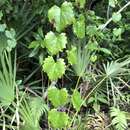ar
الأسماء في صفحات التنقل


Vitus rotundifolia, the muscadine grape, is one of about 60 species of grapes vines (genus Vitus). The muscadine grape is native to the southeastern United States from Texas to Delaware, and along the Mississippi River to Missouri. Unlike most other grape species, it is adapted to warm, humid conditions and does especially well in Florida.
The muscadine grape was the first native grape species to be cultivated in North America.It has been used for commercial wine making since the 16th century in Florida, traditionally for fine wines, port, and dessert wines.The fruit is also used for jelly, preserves, syrup, juices, sauces and eaten fresh. There are hundreds of different cultivars.The first named variety, the Scuppernong, came from North Carolina, described in 1810 by Dr. Calvin Jones.
The wild muscadine vine, ancestor to cultivated varieties, grows abundantly in swamps, sandy ridges, open or forested areas.It likes sandy, well-drained, fertile soil.Twining itself along other plants or sprawling along the ground, it can grow up to 100 feet.In the winter it loses its leaves but at other times of year the roundness of its serrated leaves is a good way to distinguish it from other grape species. While other grape species climb using forked tendrils, the muscadine grape has simple, unforked tendrils.
The muscadine grape is a dioecious species, meaning that individual plants have either female or male flowers, not both.Insects and wind carry pollen from male flowers to pollinate female flowers. The small, greenish flowers occur in a dense, branching cluster (a panicle).The flowers produce sweet, thick-skinned fruit, in bunches of 3-40.The fruit have a long growing season, taking about 100 days from fertilization to mature fruit.They turn a dark purple color and reach about 0.5-1 inch (1-2.5 cm) in diameter when they ripen in late summer. Each contains up to five seeds.Cultivated varieties have fruits of diverse sugar content and colorations from bronze, pink, greenish, yellow, white, to almost black.
The thick pigmented skins and the seeds of muscadine grapes produce many phytochemicals (including antioxidant polyphenols) thought to have considerable potential health benefits, such as control of certain cancers.They are also a good source of dietary fiber.
Muscadine vines have fewer pests than many other grape species.Aphid outbreaks sometimes occur although they usually are contained by natural predators.The grape root borer (Vitacea polistiformis) can cause damage.This grapevine is also fairly disease resistant.Its main diseases are caused by several types of fungus, but are usually treatable.The fruit is eaten by many birds and mammals, and the plant is host to several butterfly and moth species.
Some consider V. rotundifolia, along with two other grape species, members of a separate subgenus (muscadinia).Species in muscadinia are limited to the American southeast and have notable morphological differences from others in Vitus, as well as a different number of chromosomes.
(Andersen et al. 2013; California Rare Fuit Growers 1997; Christman 2010; Conner 2010; Cook 2015; WIkipedia 2015)